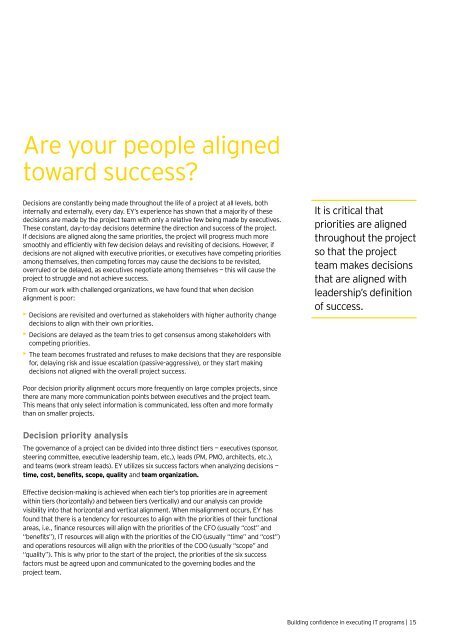Building confidence in executing IT programs
1MvMFcE
1MvMFcE
- No tags were found...
You also want an ePaper? Increase the reach of your titles
YUMPU automatically turns print PDFs into web optimized ePapers that Google loves.
Are your people aligned<br />
toward success?<br />
Decisions are constantly be<strong>in</strong>g made throughout the life of a project at all levels, both<br />
<strong>in</strong>ternally and externally, every day. EY’s experience has shown that a majority of these<br />
decisions are made by the project team with only a relative few be<strong>in</strong>g made by executives.<br />
These constant, day-to-day decisions determ<strong>in</strong>e the direction and success of the project.<br />
If decisions are aligned along the same priorities, the project will progress much more<br />
smoothly and efficiently with few decision delays and revisit<strong>in</strong>g of decisions. However, if<br />
decisions are not aligned with executive priorities, or executives have compet<strong>in</strong>g priorities<br />
among themselves, then compet<strong>in</strong>g forces may cause the decisions to be revisited,<br />
overruled or be delayed, as executives negotiate among themselves — this will cause the<br />
project to struggle and not achieve success.<br />
From our work with challenged organizations, we have found that when decision<br />
alignment is poor:<br />
• Decisions are revisited and overturned as stakeholders with higher authority change<br />
decisions to align with their own priorities.<br />
• Decisions are delayed as the team tries to get consensus among stakeholders with<br />
compet<strong>in</strong>g priorities.<br />
• The team becomes frustrated and refuses to make decisions that they are responsible<br />
for, delay<strong>in</strong>g risk and issue escalation (passive-aggressive), or they start mak<strong>in</strong>g<br />
decisions not aligned with the overall project success.<br />
It is critical that<br />
priorities are aligned<br />
throughout the project<br />
so that the project<br />
team makes decisions<br />
that are aligned with<br />
leadership’s def<strong>in</strong>ition<br />
of success.<br />
Poor decision priority alignment occurs more frequently on large complex projects, s<strong>in</strong>ce<br />
there are many more communication po<strong>in</strong>ts between executives and the project team.<br />
This means that only select <strong>in</strong>formation is communicated, less often and more formally<br />
than on smaller projects.<br />
Decision priority analysis<br />
The governance of a project can be divided <strong>in</strong>to three dist<strong>in</strong>ct tiers — executives (sponsor,<br />
steer<strong>in</strong>g committee, executive leadership team, etc.), leads (PM, PMO, architects, etc.),<br />
and teams (work stream leads). EY utilizes six success factors when analyz<strong>in</strong>g decisions —<br />
time, cost, benefits, scope, quality and team organization.<br />
Effective decision-mak<strong>in</strong>g is achieved when each tier’s top priorities are <strong>in</strong> agreement<br />
with<strong>in</strong> tiers (horizontally) and between tiers (vertically) and our analysis can provide<br />
visibility <strong>in</strong>to that horizontal and vertical alignment. When misalignment occurs, EY has<br />
found that there is a tendency for resources to align with the priorities of their functional<br />
areas, i.e., f<strong>in</strong>ance resources will align with the priorities of the CFO (usually “cost” and<br />
“benefits”), <strong>IT</strong> resources will align with the priorities of the CIO (usually “time” and “cost”)<br />
and operations resources will align with the priorities of the COO (usually “scope” and<br />
“quality”). This is why prior to the start of the project, the priorities of the six success<br />
factors must be agreed upon and communicated to the govern<strong>in</strong>g bodies and the<br />
project team.<br />
<strong>Build<strong>in</strong>g</strong> <strong>confidence</strong> <strong>in</strong> execut<strong>in</strong>g <strong>IT</strong> <strong>programs</strong> | 15



